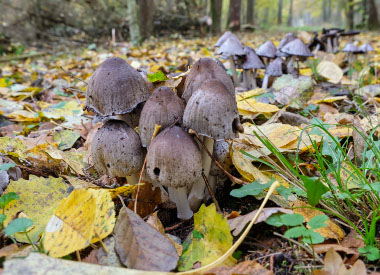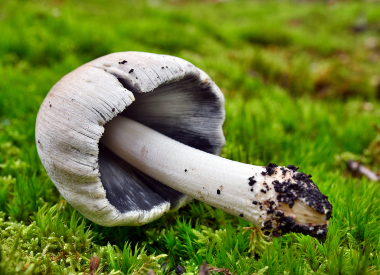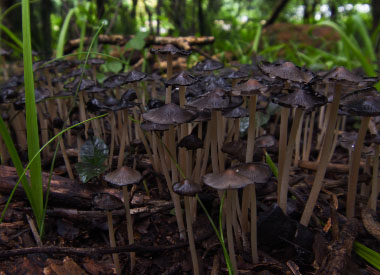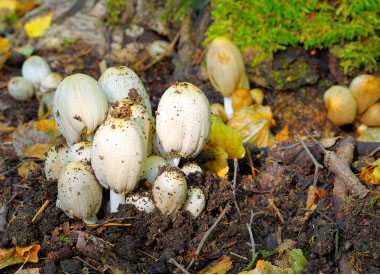





Do not eat any fungi that has not been properly identified by a qualified professional, some are DEADLY when ingested. All edible wild fungi MUST be cooked.
Coprinopsis atramentaria is a very common and easily recognized species in the Psathyrellaceae family. Inky cap is named due to the disintegration of the mushroom cap into an ink-like liquid following spore discharge. In fact, this ink-like liquid has been used for writing. This mushroom is known by many names although Inky Cap is the most commonly used. Other names include Tippler's Bane, Common Inkcap, and Alcohol Inky.
Type
Distinguishing Features
Inky Caps have a smooth to longitudinally wrinkled or scaly, silvery gray to brown cap. The cap is bullet to bell-shaped. When it first appears the cap is egg-shaped and as it matures is expands to become bell-shaped with a slight umbo before deliquescing from the margin. Once it ages, the cap turns black. On average the cap reaches a diameter of 3 to 7cm (1 to 3"). The stipe is white with reddish-brown fibrils towards the base, has an 8 to 15 mm ( 0.31 to 0.59") diameter and measures anywhere from 5 to 12 cm tall. The stipe is hollow, with a white annular zone near the base. Inky caps often occurs in dense clusters.
Height
Inky caps grow anywhere from 5 to 12 cm (2 to 5") tall.
Habitat
They typically grow on a wood substrate or on dung. They are saprobic mostly occuring on decaying wood or on the ground from buried wood. Coprinopsis atramentaria grows throughout the Northern Hemisphere, including Europe, North America, and Asia.
Spore Print
Black.
Season
May through October.
Gills
Gills are free, white when young, crowded, becoming brown then black and inky at maturity.
Edibility
Although these can be cooked and consumed, inky caps come with a warning. Alcoholic beverages should not be consumed up to 72 hours before or after eating this mushroom. The inky cap causes coprine poisoning which produces symptoms of nausea, vomiting, flushing, rapid breathing, and severe headache.
Other Name
Tippler's Bane.
Recipes
To support our efforts please browse our store (books with medicinal info, etc.).
Winter Survival Food Handbook

PDF Plant Magazines
Types of Wild Food
Geographic Zones Seasons
Disclaimer
EdibleWildFood.com is informational in nature. While we strive to be 100% accurate, it is solely up to the reader to ensure proper plant identification. Some wild plants are poisonous or can have serious adverse health effects.
We are not health professionals, medical doctors, nor are we nutritionists. It is up to the reader to verify nutritional information and health benefits with qualified professionals for all edible plants listed in this web site. Please click here for more information.
Why Edible Wild Food?
- Food costs are rising
- Free, wild food is readily abundant
- Wild food adds nutrition to your diet
- Wild food can help treat various medical conditions





